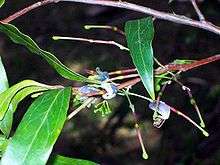Grevillea shiressii
| Grevillea shiressii | |
|---|---|
 | |
| Scientific classification | |
| Kingdom: | Plantae |
| (unranked): | Angiosperms |
| (unranked): | Eudicots |
| Order: | Proteales |
| Family: | Proteaceae |
| Genus: | Grevillea |
| Species: | G. shiressii |
| Binomial name | |
| Grevillea shiressii Blakely | |
Grevillea shiressii is an Australian shrub of the family Proteaceae endemic to New South Wales, where it is found in only two localities near Gosford.
Description
Grevillea shiressii grows as a woody shrub, reaching 2–5 m (6.6–16.4 ft) high. It has shiny lanceolate (spear-shaped) to elliptic leaves which are 8 to 19 cm (3.1 to 7.5 in) long and 1–3 cm (0.39–1.18 in) across, with undulate (wavy) margins.[1] The inflorescences (flower heads) appear from July to December,[2] and are composed of two to nine individual flowers.[1]
Taxonomy
William Blakely described this species in 1925,[3] naming it in honour of his companion on many forays David William Campbell Shiress.[4]
It is related to Grevillea singuliflora.[4]
Distribution and habitat
A rare plant, listed as vulnerable with a ROTAP rating of 2VCit, it is only found growing naturally in the area around Gosford north of Sydney. Grevillea shiressii is only found along two tributaries of the Hawkesbury River – Mullet Creek and Mooney Mooney Creek.[5] Growing on alluvial sandy soils, it is a component of wet sclerophyll forest. It grows under such trees as mountain blue gum (Eucalyptus deanei), turpentine (Syncarpia glomulifera) and rough-barked apple (Angophora floribunda), and alongside watergum (Tristaniopsis laurina) and river lomatia (Lomatia myricoides).[2]
There is also a naturalised population of Grevillea shiressii in Newcastle.[1]
Ecology
Birds forage among and pollinate the flowers, while ants disperse the seeds. Wasps of the genus Eurytoma prey on the seeds.[2]
Grevillea shiressii is killed by fire and regenerates from seed.[2]
Cultivation
Grevillea shiressii grows into a bushy shrub in the garden, its flowers attracting birds and providing shelter for them. Its foliage is a feature. It can be propagated readily by seed or cutting. A cultivar known as G. 'Ruby Clusters' or G. 'Splendour' is a hybrid between G. shiressii and either G. oleoides or G. speciosa, with the red flowers of these species and the foliage of the former.[4]
References
- 1 2 3 Makinson, Robert O. "New South Wales Flora Online: Grevillea shiressii". Royal Botanic Gardens & Domain Trust, Sydney, Australia. Retrieved 7 January 2013.
- 1 2 3 4 Benson, Doug; McDougall, Lyn (2000). "Ecology of Sydney Plant Species Part 7b: Dicotyledon families Proteaceae to Rubiaceae" (PDF). Cunninghamia. 6 (4): 1017–1202.
- ↑ "Grevillea shiressii Blakely". Australian Plant Name Index (APNI), IBIS database. Centre for Plant Biodiversity Research, Australian Government. Retrieved 7 January 2013.
- 1 2 3 Olde, Peter; Marriott, Neil (1995). The Grevillea Book Volume 3. Australia: Kangaroo Press. pp. 170–71. ISBN 0864176112.
- ↑ Department of Environment & Heritage (7 September 2012). "Grevillea shiressii - profile". Environmental Issues. New South Wales Government. Retrieved 10 January 2013.
